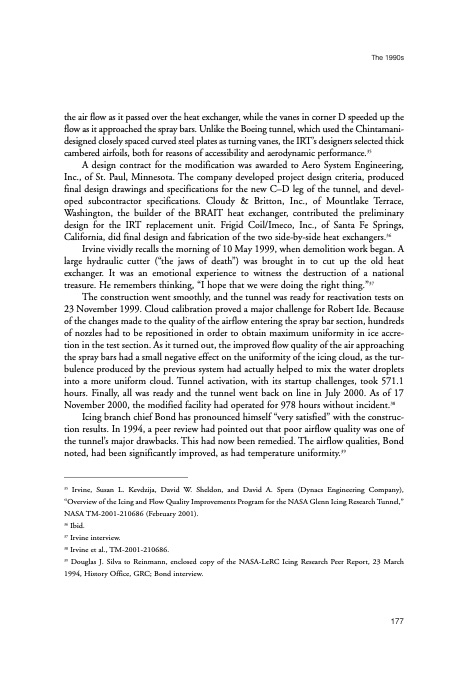
PDF Publication Title:
Text from PDF Page: 188
the air flow as it passed over the heat exchanger, while the vanes in corner D speeded up the flow as it approached the spray bars. Unlike the Boeing tunnel, which used the Chintamani- designed closely spaced curved steel plates as turning vanes, the IRT’s designers selected thick cambered airfoils, both for reasons of accessibility and aerodynamic performance.35 A design contract for the modification was awarded to Aero System Engineering, Inc., of St. Paul, Minnesota. The company developed project design criteria, produced final design drawings and specifications for the new C–D leg of the tunnel, and devel- oped subcontractor specifications. Cloudy & Britton, Inc., of Mountlake Terrace, Washington, the builder of the BRAIT heat exchanger, contributed the preliminary design for the IRT replacement unit. Frigid Coil/Imeco, Inc., of Santa Fe Springs, California, did final design and fabrication of the two side-by-side heat exchangers.36 Irvine vividly recalls the morning of 10 May 1999, when demolition work began. A large hydraulic cutter (“the jaws of death”) was brought in to cut up the old heat exchanger. It was an emotional experience to witness the destruction of a national treasure. He remembers thinking, “I hope that we were doing the right thing.”37 The construction went smoothly, and the tunnel was ready for reactivation tests on 23 November 1999. Cloud calibration proved a major challenge for Robert Ide. Because of the changes made to the quality of the airflow entering the spray bar section, hundreds of nozzles had to be repositioned in order to obtain maximum uniformity in ice accre- tion in the test section. As it turned out, the improved flow quality of the air approaching the spray bars had a small negative effect on the uniformity of the icing cloud, as the tur- bulence produced by the previous system had actually helped to mix the water droplets into a more uniform cloud. Tunnel activation, with its startup challenges, took 571.1 hours. Finally, all was ready and the tunnel went back on line in July 2000. As of 17 November 2000, the modified facility had operated for 978 hours without incident.38 Icing branch chief Bond has pronounced himself “very satisfied” with the construc- tion results. In 1994, a peer review had pointed out that poor airflow quality was one of the tunnel’s major drawbacks. This had now been remedied. The airflow qualities, Bond noted, had been significantly improved, as had temperature uniformity.39 The 1990s 35 Irvine, Susan L. Kevdzija, David W. Sheldon, and David A. Spera (Dynacs Engineering Company), “Overview of the Icing and Flow Quality Improvements Program for the NASA Glenn Icing Research Tunnel,” NASA TM-2001-210686 (February 2001). 36 Ibid. 37 Irvine interview. 38 Irvine et al., TM-2001-210686. 39 Douglas J. Silva to Reinmann, enclosed copy of the NASA-LeRC Icing Research Peer Report, 23 March 1994, History Office, GRC; Bond interview. 177PDF Image | History of NASA Icing Research Tunnel

PDF Search Title:
History of NASA Icing Research TunnelOriginal File Name Searched:
sp4226.pdfDIY PDF Search: Google It | Yahoo | Bing
NFT (Non Fungible Token): Buy our tech, design, development or system NFT and become part of our tech NFT network... More Info
IT XR Project Redstone NFT Available for Sale: NFT for high tech turbine design with one part 3D printed counter-rotating energy turbine. Be part of the future with this NFT. Can be bought and sold but only one design NFT exists. Royalties go to the developer (Infinity) to keep enhancing design and applications... More Info
Infinity Turbine IT XR Project Redstone Design: NFT for sale... NFT for high tech turbine design with one part 3D printed counter-rotating energy turbine. Includes all rights to this turbine design, including license for Fluid Handling Block I and II for the turbine assembly and housing. The NFT includes the blueprints (cad/cam), revenue streams, and all future development of the IT XR Project Redstone... More Info
Infinity Turbine ROT Radial Outflow Turbine 24 Design and Worldwide Rights: NFT for sale... NFT for the ROT 24 energy turbine. Be part of the future with this NFT. This design can be bought and sold but only one design NFT exists. You may manufacture the unit, or get the revenues from its sale from Infinity Turbine. Royalties go to the developer (Infinity) to keep enhancing design and applications... More Info
Infinity Supercritical CO2 10 Liter Extractor Design and Worldwide Rights: The Infinity Supercritical 10L CO2 extractor is for botanical oil extraction, which is rich in terpenes and can produce shelf ready full spectrum oil. With over 5 years of development, this industry leader mature extractor machine has been sold since 2015 and is part of many profitable businesses. The process can also be used for electrowinning, e-waste recycling, and lithium battery recycling, gold mining electronic wastes, precious metals. CO2 can also be used in a reverse fuel cell with nafion to make a gas-to-liquids fuel, such as methanol, ethanol and butanol or ethylene. Supercritical CO2 has also been used for treating nafion to make it more effective catalyst. This NFT is for the purchase of worldwide rights which includes the design. More Info
NFT (Non Fungible Token): Buy our tech, design, development or system NFT and become part of our tech NFT network... More Info
Infinity Turbine Products: Special for this month, any plans are $10,000 for complete Cad/Cam blueprints. License is for one build. Try before you buy a production license. May pay by Bitcoin or other Crypto. Products Page... More Info
| CONTACT TEL: 608-238-6001 Email: greg@infinityturbine.com | RSS | AMP |